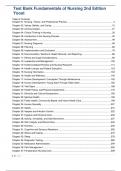Exam (elaborations)
Test Bank Fundamentals of Nursing 2nd Edition Yoost
- Course
- Institution
Test Bank Fundamentals of Nursing 2nd Edition Yoost Table of Contents Chapter 01: Nursing, Theory, and Professional Practice ........................................................................ 2 Chapter 02: Values, Beliefs, and Caring .............................................................
[Show more]



